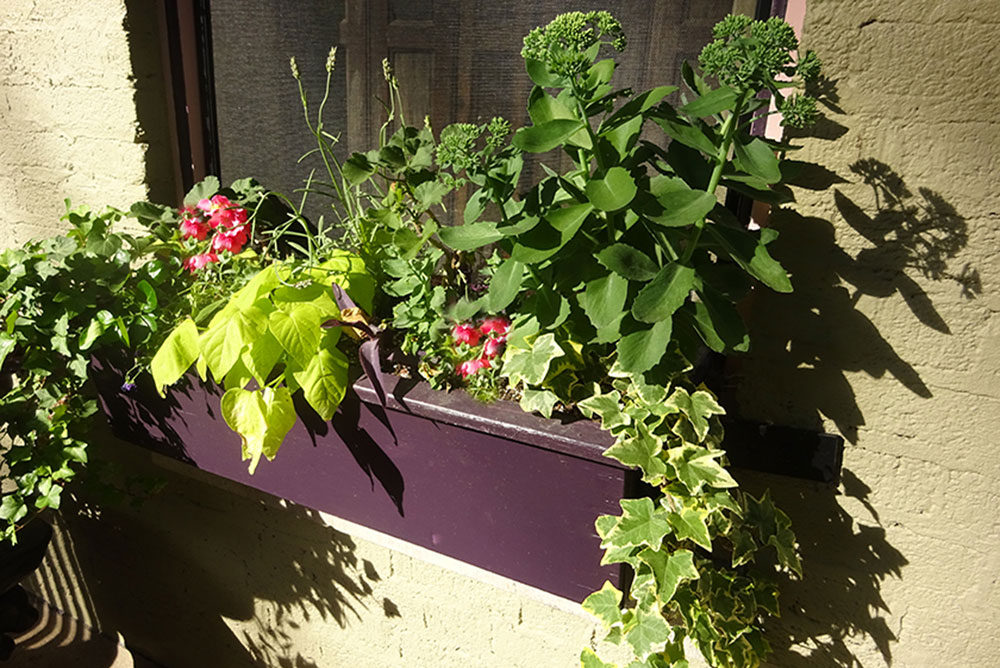
Sedum snipped from the back garden is taking off in the right corner of this window box. In the center is a French lavender cleaved in two—the other half is in an adjacent box. Ivy spilling over the sides provides a permanent frame. Seasonal additions include sweet potato vine, which will ruffle down to the ground by August, pink geraniums, a mystery plant that is doing very well—I always think I’ll remember its name, and don’t. With a little luck, the moonflower seeds will sprout, flower and scent the late summer night air. / Photo by Stephanie Cavanaugh.
I’M EXPERIMENTING. Snipping this and that, a pinch here, a chop there; fearless in my propagating.
Thirty-odd years ago, just having moved to a house with a clothesline and a twig of a tree in the little back yard, I wanted an instant garden. An ancient book, long turned to mulch, had a chapter that suggested one could immediately create a fabulous border by interspersing fast-growing shrubs and annuals with slower-growing perennials, the latter being the plants you eventually wanted to be the stars of your garden. When the permanent plantings matured to your liking, you yanked out the understudies.
Fat chance with My Prince, a borderline hoarder who rarely gets rid of anything. It took me three years to get him to agree to remove a yucca, which did erupt dramatically with great white-flowering panicles bursting from brutally pointed spikes. While such flamboyance is always among my first orders of garden business, this plant, which sat beside the patio dining table, was always unappetizingly covered with ants. If he wouldn’t remove that, how could I talk him into deliberately removing healthy vegetation? I have a hard enough time explaining that annuals are intended to last just one season.
What a waste of money, he says (and says) about buying flats of begonias and impatiens. Sigh. In a way, however, he’s right. There are so many more interesting plants to be gathered, or purloined by stem or seed. One just needs to be willing to wait for results and not weep when he stomps on or yanks them in one of his fits of helpfulness.
Someday I’ll discuss how he learned to edge a path—watching his Uncle Ed, who drove a Cadillac and therefore was to be respected, tame the lines of the walkway to the house. Phooey.
Returning to the subject at hand. The rush for the finished garden no longer matters as over the years I have discovered . . . patience! The excitement of making more plants from bits of those I admire and then eagerly anticipating the results: watching the dirt, waiting for a bud to emerge; fretting that the bud, when it appears, might be a weed, and not even an interesting one—like sometimes weird-looking babies are more captivating than those Gerber types, you know? They smile at you gummily, not yet realizing they’re not Brad or Angelina, enchanting.
Weeds can be like that too. Last year there were these oddly ugly carroty-topped items that cropped up in the front garden. As I have a habit of lazily strewing seeds before a rain, I thought they could be something. My neighbor Peter and I spent much time standing around contemplating them. As doing nothing is far easier than working, a tactic we both appreciate, I left them alone. And, lo! I was suddenly gifted with lacy stands of Queen Anne’s lace. They’re so invasive they’re said to be nearly impossible to eradicate, which always delights me.
Returning, yet again, to the subject at hand. So many plants multiply with ease.
Once more I offer the wandering Jew, which does yeoman service as filler, wherever it is you need one—hanging basket, window box or border. Stick a stem in soil and there it goes. Sedum is about as easy, fat stemmed and juicy, busily free-flowering. There was a clump overgrowing near the pond that I experimentally clipped last summer, sticking a couple of sprigs into the corners of the window boxes where they quickly went mad, staying green all winter, which is always a blessing, and just now beginning to flower a mildly lively pink.
Geraniums are amazingly easy to propagate. You can make a pretty respectable-looking pot of them, including flowers, in about 10 minutes. Break one apart, dip the stems in rooting compound, stick them in dirt. The end. I have not bought a geranium in years.
A few weeks ago I held my breath and whacked a French lavender of particularly heady scent into two, one part for each of my lower window boxes. They’re doing brilliantly, shooting florets into a spray against the glass.
Along those lines, if a hanging basket of whatever I’m hungering for is cheaper than the market pack, I buy it and gently break it apart, retaining the roots on each clump, then planting the bits, thus making much more out of less. If this seems a stupid tip to you, swell. It took me years to be that daring.
While you can Google any plant for growing tips, Plant Propagation, by Alan Toogood, published by the American Horticultural Society covers it all, with photos and illustrations that make it easy for even the most casual gardeners, a group that includes me.
He covers everything from separating bulbs and gathering seeds, to telling you when you might expect results from your efforts. Some plants take off in days, others take years, which is fine information to have. You can have only so much patience.
—Stephanie Cavanaugh
Read more of Stephanie’s Green Acre posts here.
